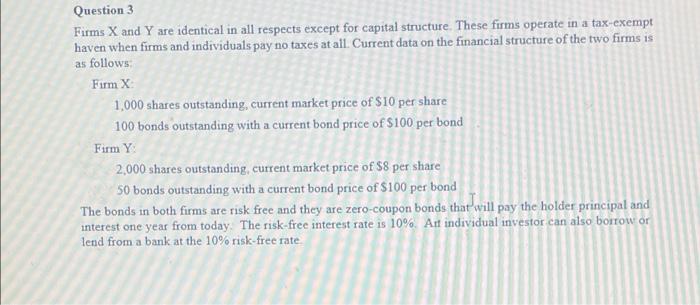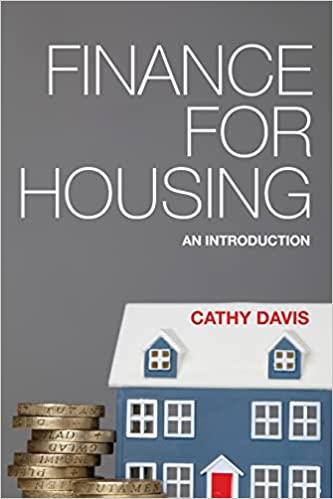b) Suppose that firm Y is planning on issuing $2,000 in new stock and using the proceeds to repurchase some of the existing bonds Investor ABC currently owns 40 shares of stock in Form Y and is concerned that the stock will offer a lower return after the financial restructuring because she correctly) anticipates that the stock will be less risky with lower leverage. She wants to counteract the firm's financial restructuring so that her payoffs are exactly the same as before the restructuring What financial transactions after the restructuring will enable her to replicate the original payoffs from her investment in Firm Y? Question 3 Firms X and Y are identical in all respects except for capital structure. These firms operate in a tax-exempt haven when firms and individuals pay no taxes at all. Current data on the financial structure of the two firms is as follows Firm X 1,000 shares outstanding, current market price of $10 per share 100 bonds outstanding with a current bond price of $100 per bond Firm Y 2,000 shares outstanding, current market price of $8 per share 50 bonds outstanding with a current bond price of $100 per bond The bonds in both firms are risk free and they are zero-coupon bonds that will pay the holder principal and interest one year from today. The risk-free interest rate is 10%. Att individual investor can also borrow or lend from a bank at the 10% risk-free rate b) Suppose that firm Y is planning on issuing $2,000 in new stock and using the proceeds to repurchase some of the existing bonds Investor ABC currently owns 40 shares of stock in Form Y and is concerned that the stock will offer a lower return after the financial restructuring because she correctly) anticipates that the stock will be less risky with lower leverage. She wants to counteract the firm's financial restructuring so that her payoffs are exactly the same as before the restructuring What financial transactions after the restructuring will enable her to replicate the original payoffs from her investment in Firm Y? Question 3 Firms X and Y are identical in all respects except for capital structure. These firms operate in a tax-exempt haven when firms and individuals pay no taxes at all. Current data on the financial structure of the two firms is as follows Firm X 1,000 shares outstanding, current market price of $10 per share 100 bonds outstanding with a current bond price of $100 per bond Firm Y 2,000 shares outstanding, current market price of $8 per share 50 bonds outstanding with a current bond price of $100 per bond The bonds in both firms are risk free and they are zero-coupon bonds that will pay the holder principal and interest one year from today. The risk-free interest rate is 10%. Att individual investor can also borrow or lend from a bank at the 10% risk-free rate








